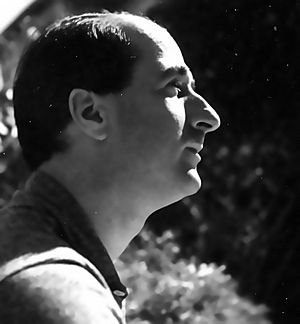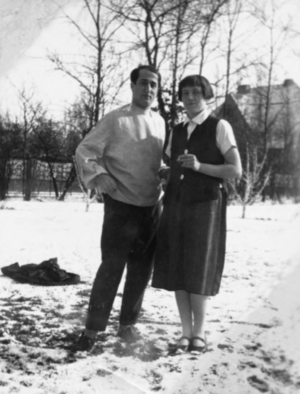Stefan Wolpe facts for kids
Stefan Wolpe (born August 25, 1902, in Berlin; died April 4, 1972, in New York City) was a German-Jewish-American composer. He was known for his modern and varied music style. He connected with many different art groups, like the Bauhaus art school and the kibbutz movement (farming communities in Israel).
Wolpe lived and worked in Berlin until the Nazis took control in 1933. This forced him to move. He lived in Vienna (1933–34) and Jerusalem (1934–38) before finally settling in New York City (1938–72). His music, like Battle Piece (1942/1947), often showed how he felt about moving around so much. He also wrote about this in his many diaries and letters. His music was a mix of many styles, including modern classical music, bebop jazz, and traditional Arab music.
Contents
Wolpe's Early Life and Studies
Wolpe was born in Berlin, Germany. He started studying music at the Klindworth-Scharwenka Conservatory when he was 14. He also attended the Berlin Hochschule für Musik in 1920–21. He learned composition from famous teachers like Franz Schreker and Ferruccio Busoni. Around 1923, he also studied at the Bauhaus, which was a famous art and design school. There, he met some dada artists, who liked to create art that was unusual and playful. Wolpe even set one of their poems, An Anna Blume by Kurt Schwitters, to music.
Operas and Family Life
In 1928, Wolpe's first opera, Zeus und Elida, was performed in Berlin. An opera is a play where most of the words are sung. Soon after, he had two more operas, Schöne Geschichten and Anna Blume, in 1929.
In 1927, he married an artist named Ola Okuniewska from Czechoslavakia. Their daughter, Katharina Wolpe, was born in 1931. However, Stefan and Ola separated. Ola moved to London in 1938. During World War II, their daughter Katharina was in Berne, Switzerland, and was mostly on her own.
Music for Social Change
Between 1929 and 1933, Wolpe wrote music that sounded "dissonant," meaning it used notes that might sound clashing or unusual together. He used a method called the twelve-tone technique, which was developed by Arnold Schoenberg. This technique uses all 12 notes of the musical scale equally, instead of focusing on a main key.
Wolpe was also a strong socialist, someone who believes in social equality. He was influenced by Paul Hindemith's idea of Gebrauchsmusik, which means "music for use." This was music created for a specific purpose, often for social events. Because of his beliefs, Wolpe wrote many pieces for workers' unions and communist theater groups. For these pieces, he made his music easier to understand, adding parts of jazz and popular music.
Moving Away from Nazi Germany
When the Nazis came to power in Germany, Wolpe had to leave. He was Jewish and a communist, and the Nazis persecuted both groups. He traveled through Romania and Russia before arriving in Austria in 1933–34. There, he met and studied with another famous composer, Anton Webern.
Wolpe had left Germany with a Romanian pianist. In Vienna, he married Irma Schoenberg. He then moved to Mandatory Palestine (now Israel) in 1934–38. While there, he wrote simple songs for the kibbutzim, which were farming communities. However, the music he wrote for concerts was still very complex and "atonal," meaning it didn't have a clear musical key. Because of this, his teaching job at the Palestine Conservatoire was not renewed.
Life in New York City
In 1938, Wolpe moved to New York City. He briefly saw his daughter in London in 1946. In the 1950s, he became friends with abstract expressionist painters. These artists created art that focused on expressing emotions through abstract forms. His third wife, the poet Hilda Morley, introduced him to them.
From 1952 to 1956, Wolpe was the director of music at Black Mountain College, an experimental school in North Carolina. On January 24, 1956, he joined the faculty at C.W. Post College of Long Island University in New York. He also gave lectures at summer music schools in Darmstadt, Germany. Many students learned from him, including Morton Feldman, David Tudor, and Gil Evans.
Later Music Styles
Wolpe's music from this time continued to be very diverse. Sometimes he used the twelve-tone technique. Other times, his music was "diatonic," meaning it used the notes of a standard major or minor scale. He also used Arabic scales, like the maqam saba, which he had heard in Palestine. Sometimes he used other ways to organize his music's sounds.
In 1964, Wolpe developed Parkinson's disease, a condition that affects movement. He passed away in New York City in 1972.
Wolpe's Music Style
The famous composer Elliott Carter once said about Wolpe's music, "he does everything wrong and it comes out right." This means that even though Wolpe's music often broke traditional rules, it still sounded good and interesting. His music was known for being very complex and mixing many different ideas and sounds.
See also
 In Spanish: Stefan Wolpe para niños
In Spanish: Stefan Wolpe para niños



